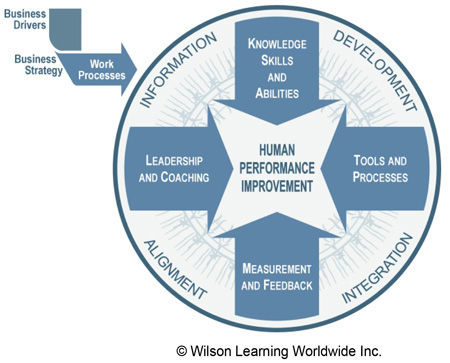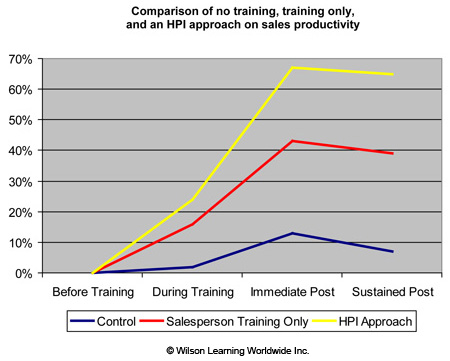Une approche de l’efficacité commerciale par l’amélioration de la performance humaine
Executive Summary
High-performing sales organizations have long used well-targeted training to close skill or knowledge gaps critical to their sales force effectiveness, and there have been several studies showing the impact of salesperson training on sales performance. There is also a strong belief that salesperson training alone is not as effective as training combined with changes in the work processes and management of salespeople. Unfortunately, few studies address the question of how much more effective sales training can be if a systematic approach is taken to human performance improvement. As a result, some organizations are reluctant to make the investment required to implement such a systematic approach.
This study shows that salesperson training can produce improved sales performance, but that the improvements are more dramatic when that training is accompanied by changes in the sales environment. In this study, we found that sales training is 67% more effective when accompanied by changes in the environment—specifically, training for sales managers to coach and support application of the learning, and the addition of tools to support new skill sets. This study shows that when an organization moves away from a traditional training mindset to one that uses a Human Performance Improvement framework, greater and more sustained improvements in salesperson and organizational performance are created.
Human Performance Improvement
It is an experience common to every traditional sales training effort. Salespeople leave a training seminar armed with a new selling perspective and new skills that they are ready and willing to use, but then return to the same, unchanged sales environment—An environment in which sales tools and procedures have not been adjusted to support the new skills and where managers don't know how to support salespeople in their efforts to apply the new skills, or even assess how well the salespeople are using the skills with their customers.
A Human Performance Improvement approach to organizational improvement recognizes that any development effort implemented in isolation will produce only limited results. Implementing a new sales system or procedure without appropriate training or coaching will not produce sales improvement. Similarly, any sales training programme implemented without tools and manager support will also have limited impact.
An approach to training that acknowledges the critical role of tools, measurement, and management support will enhance and extend the impact of learning. At Wilson Learning, we call this our Human Performance Improvement (HPI) process. It is represented in the graphic.

A full description of HPI is available in a separate document. Briefly, we believe there are three elements to a training and development effort that are critical to creating maximum results:
- Establishing a Business Case: Establishing a business case for performance improvement by linking specific strategic drivers to skill requirements
- Understanding the Challenge: Making effective decisions about what skills to focus on, selecting delivery methods, and determining how to integrate into the organization and how to align all key stakeholders to support this approach to performance improvement
-
Creating Integrated Solutions: Creating the performance improvement elements necessary to address the challenge and accomplish the strategy
- Developing learning components to deliver the knowledge, skills, and abilities
- Developing work tools and process to support the use of the learning
- Providing organizations with the ability to track the impact of the learning on performance
- Ensuring that managers are prepared to support and coach the application of the skills
It is our experience that by identifying and implementing components that address these three areas, you can maximize the impact of training and development on your organization’s results. This study shows that when you do implement multiple elements of the HPI approach, the results dramatically exceed those gained by training alone. This is especially true of creating integrated solutions, which is imperative to sustained human performance improvement.
Proving the Impact of a Human Performance Improvement Approach
To prove that our HPI approach to development is superior to a traditional training approach, we needed an opportunity to compare training alone to training plus the other components of HPI. We had such an opportunity in our work with a large U.S. travel services organization. They asked us to train their salespeople on a new approach to selling using Wilson Learning's Counselor Salesperson technology. This organization agreed to let us study the relative impact of the HPI approach on learning compared to a traditional approach of just training salespeople and to a control group of salespeople who received no training at all. In all, 246 salespeople and sales managers participated in this study, which took place over an 18-month period.
Study Groups
The salespeople and managers were divided into three equal-sized groups:
- No Training Control: One group of salespeople and their managers received no training at all during this study period. This allowed us to determine whether the training was effective and to rule out non-training effects, such as general economic conditions.
- Salesperson Training Only: A second group of salespeople received a two-day training programme designed to teach Counselor Salesperson skills. (A full description of the Counselor Salesperson programme is available in a separate document.)
-
HPI Approach: The final group of salespeople also received the Counselor Salesperson training. But in addition:
- Managers received training in the same Counselor Salesperson skills, plus additional training on how to coach salespeople on the use of the skills and how to monitor the implementation of the skills by their salespeople.
- Salespeople received a variety of tools (forms, checklists, etc.) to help them implement their new skills.
The salespeople in all three groups were equivalent in age, sales experience, and sales productivity before the training began. As a result, we felt comfortable that any changes in performance over the course of the study were due to the training and HPI techniques, not to differences in the salespeople themselves.
Performance Measure
We used sales revenue to determine the impact of the training on sales performance. We believed this was the most direct way to measure performance. This organization reported sales revenue figures in three-month periods (quarters); so, for the 18 months of this study, our revenue tracking resulted in six separate study periods.
| Study Period | Activity | Description |
|---|---|---|
| Quarters 1–2 | Pre-training | Data collected during this period was used to establish a baseline of performance before anyone received training. |
| Quarters 3–4 | During Training | This was the six months during which 164 salespeople and managers in the training groups received training. The remaining 82 salespeople were in the No Training Control group. |
| Quarter 5 | Immediate Post | This was the three months immediately after all the training was completed. |
| Quarter 6 | Sustained Post | This period was included to determine the sustainability of the improvement. |
Findings
Since actual revenue results cannot be shown (in order to protect the proprietary information of the organization), results are shown as the percent of improvement compared to the pre-training baseline. These results are shown in the following graph.

There are two principal research questions being asked in this study:
- Does the salesperson training alone create improved sales performance? This is determined by comparing the No Training Control group to the Salesperson Training Only group.
- Does the HPI Approach create greater improvement than salesperson training alone? This is determined by comparing the Salesperson Training Only group to the HPI Approach group.
The graph at right shows the answer to both questions is yes. Performance for the No Training Control group (the blue line) changed little during the 18 months of the study. The greatest improvement was a 16% performance increase during the Immediate Post period, which then declined to an improvement of 7% over baseline during the Sustained Post period. The fact that the control group went up, even slightly, suggests that there might have been some broad industry or economic changes also affecting the results. Thus, the most critical comparisons are how much more the Salesperson Training Only and HPI groups improved relative to the control group.
When you compare the No Training Control group to the Salesperson Training Only group (the red line), you can see the impact of salesperson training in isolation. During the six-month training period, performance increased 16% over the baseline, and then showed a 43% increase over the baseline during the three months immediately after training was completed. This was 2.3 times the increase of the control group. Finally, 90% of the performance improvement was maintained; the study ended with a 39% increase in revenue during the Sustained Post period, or 5.6 times the improvement of the control group.
As dramatic as the Salesperson Training Only group’s performance improvement was, the improvement when a full HPI solution was implemented was astounding. In the three months immediately after all of the training had been completed, performance of the HPI Approach group showed a 67% improvement over baseline—4.2 times the improvement of the control group, and 56% higher than the Salesperson Training Only group. And, this performance was sustained, dropping less than 3% from this high, for an improvement of 65% relative to the baseline during the Sustained Post period.
The ROI of a Human Performance Improvement Effort
The concept of supporting the application of new skill training is not new. So why have organizations not implemented HPI efforts more consistently in the past? One of the principle barriers has been a belief that creating and implementing these additional elements of an HPI framework will not produce enough of a return to justify their cost. For example, the implementation of salesperson training has a direct and measurable impact on performance, but the value of sales manager training, tools to support the new skills, and new measures of sales performance have not been directly assessed.
When taken as a whole, this study demonstrates that the ROI of the HPI components actually exceeds the ROI of sales training alone. That is, the cost of sales manager training and implementation of new tools and measures was only about 20% of the cost of the initial salesperson training, but produced 67% additional improvement in performance. We calculated that, if the results were extrapolated over a three-year period (during which the skills might be expected to be retained), the ROI for the salesperson training alone was about $12 for each dollar invested, but $20 for each dollar invested for the HPI approach. The HPI figures would likely be even higher, because the skills were sustained at a higher level longer with the HPI approach. Clearly, it pays to implement an HPI approach to learning.
Additional Resources
This additional article is available from Wilson Learning Worldwide:
Human Performance Improvement: Connecting People and Performance to Business Strategy








 Merci de remplir ce formulaire afin de télécharger Une approche de l’efficacité commerciale par l’amélioration de la performance humaine».
Merci de remplir ce formulaire afin de télécharger Une approche de l’efficacité commerciale par l’amélioration de la performance humaine».



